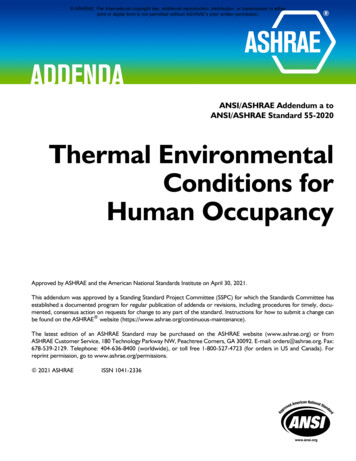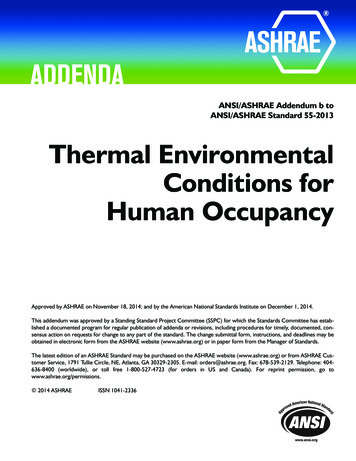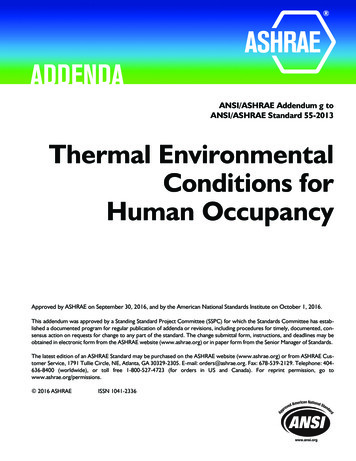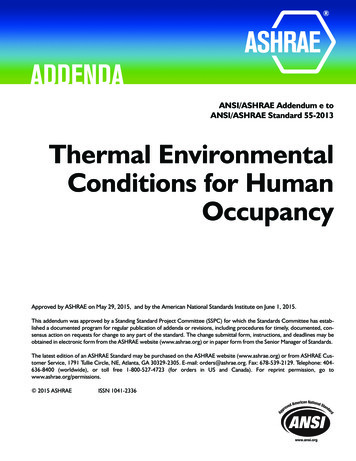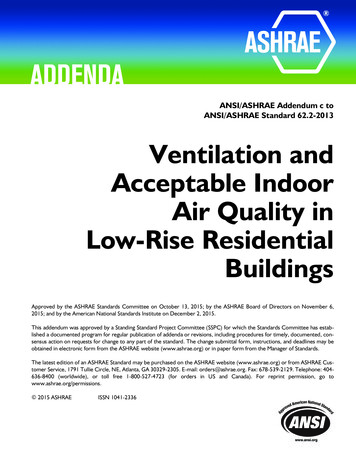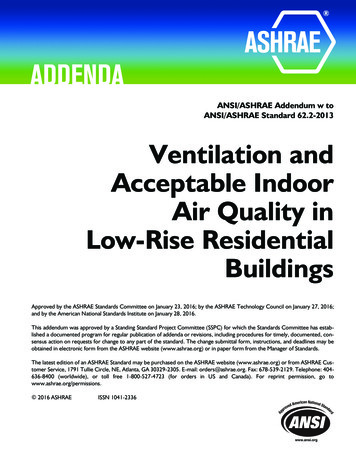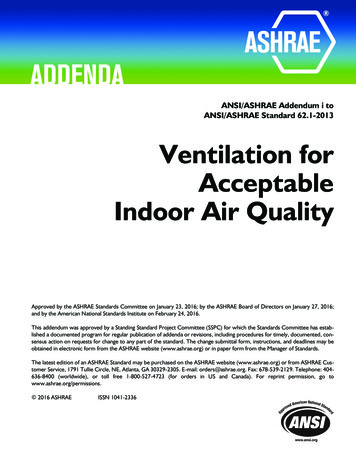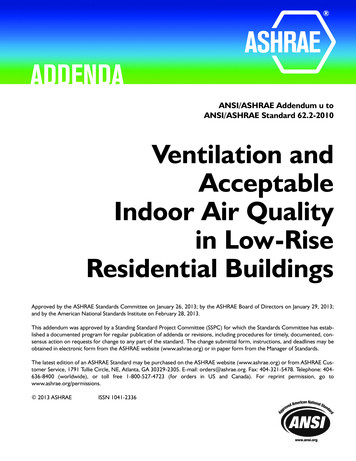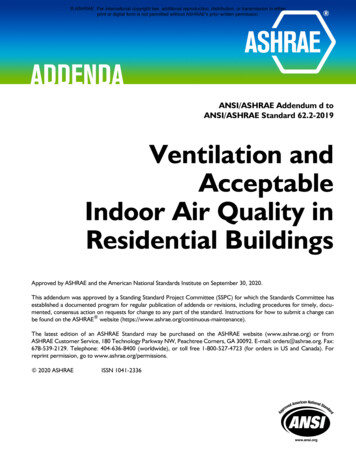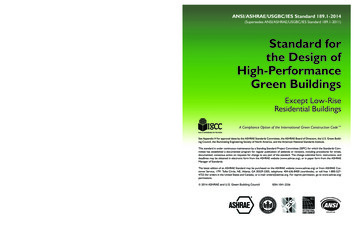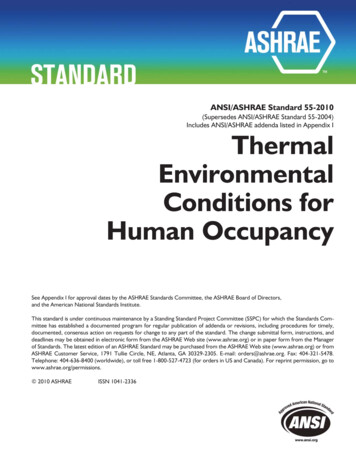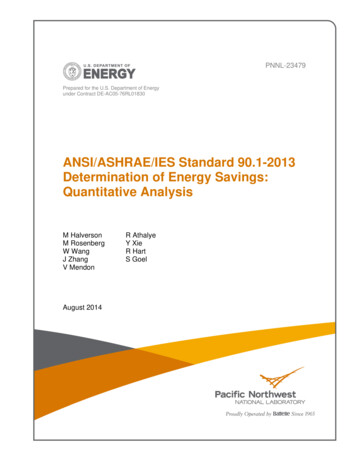
Transcription
PNNL-23479Prepared for the U.S. Department of Energyunder Contract DE-AC05-76RL01830ANSI/ASHRAE/IES Standard 90.1-2013Determination of Energy Savings:Quantitative AnalysisM HalversonM RosenbergW WangJ ZhangV MendonAugust 2014R AthalyeY XieR HartS Goel
PNNL-23479ANSI/ASHRAE/IESStandard 90.1-2013 Determinationof Energy Savings:Quantitative AnalysisM HalversonM RosenbergW WangJ ZhangV MendonR AthalyeY XieR HartS GoelAugust 2014Prepared forthe U.S. Department of Energyunder Contract DE-AC05-76RL01830Pacific Northwest National LaboratoryRichland, Washington 99352
Executive SummarySection 304(b) of the Energy Conservation and Production Act (ECPA), as amended, requires theSecretary of Energy to make a determination each time a revised version of ASHRAE Standard 90.1 ispublished with respect to whether the revised standard would improve energy efficiency in commercialbuildings. When the U.S. Department of Energy (DOE) issues an affirmative determination on Standard90.1, states are statutorily required to certify within two years that they have reviewed and updated thecommercial provisions of their building energy code, with respect to energy efficiency, to meet or exceedthe revised standard.To meet these statutory requirements, the DOE Building Energy Codes Program (BECP) and PacificNorthwest National Laboratory (PNNL) conduct two types of analysis in a determination of energysavings for a revised Standard 90.1: Qualitative Analysis: This is a detailed textual analysis that identifies all the changes made to theprevious edition of Standard 90.1 and categorizes the changes as having a positive, negative, orneutral impact on energy efficiency in commercial buildings. In the qualitative analysis, no attempt ismade to estimate a numerical impact using whole building simulation. Three steps are typicallyundertaken in the qualitative analysis: identify all changes made to Standard 90.1, characterize theimpact of each change on the energy efficiency of Standard 90.1, and identify those changes that canbe incorporated into the subsequent quantitative analysis. Quantitative Analysis: This analysis uses the results of the qualitative analysis to identify whichchanges should be incorporated into the building simulation models to estimate the energy impactresulting from the changes to Standard 90.1.This report provides the quantitative analysis to assess whether buildings constructed according to therequirements of ANSI/ASHRAE/IES Standard 90.1-2013 would result in improved energy efficiency incommercial buildings. The analysis considered each of the addenda to Standard 90.1-2010 that wereincluded in Standard 90.1-2013. PNNL reviewed all addenda included by ASHRAE in creating Standard90.1-2013 from Standard 90.1-2010, and considered their combined impact on a suite of prototypebuilding models across all U.S. climate zones. . Out of the 110 total addenda, 30 were identified as havinga measureable and quantifiable impact.The present analysis builds on previous work by PNNL to assess the energy performance of recenteditions of Standard 90.1. 1 A suite of 240 computer energy simulations for prototype buildingscomplying with Standard 90.1-2010 was developed, a combination of 16 prototype buildings in all15 U.S.climate zones. These prototypes were then modified in accordance with the addenda with quantifiableimpacts on energy efficiency to create a second suite of corresponding building simulations reflecting thesame buildings complying with Standard 90.1-2013. The building simulations were conducted using theDOE EnergyPlus Version 8.0 2 building simulation software. The resulting energy use from the completesuite of 480 simulation runs was then converted to energy use intensity (EUI, or energy use per unit floor1Thornton et al. 2011. Achieving 30% Goal: Energy and Cost Saving Analysis of ASHRAE/IES Standard 90.1-2010.Pacific Northwest National Laboratory, Richland, Washington. Available /documents/codes/PNNL-20405.pdf.2DOE. 2013. Energy Plus Energy Simulation Software, Version 8.0. U.S. Department of Energy, Washington, D.C.Available at .iii
area) metrics (site EUI, primary EUI), and energy cost intensity (ECI) results for each simulation. Foreach edition of the standard, these EUIs and ECIs were then aggregated to a national basis for eachprototype using weighting factors based on construction floor area developed for each of the 15 U.S.climate zones using commercial construction data (Jarnagin and Bandyopadhyay 2010). When compared,the resulting weighted EUIs indicated that each of the 16 prototype buildings used less energy underStandard 90.1-2013 than under Standard 90.1-2010 on a national basis when considering site energy,primary energy, or energy cost. The EUIs were also aggregated across building types to a nationalcommercial building basis using the same weighting data.On a national basis, the quantitative analysis estimated a floor-space-weighted national averagereduction in new building energy consumption of 8.5% for source energy and 7.6% when considering siteenergy. An 8.7% savings in energy cost, based on national average commercial energy costs forelectricity and natural gas, was also estimated. National savings results by building type are shown inFigure E-1 and Tables E1, E2, and E3.Figure E.1. Percentage Savings by Building Type from 90.1-2010 to 90.1-2013iv
Table E.1. Estimated Energy Use Intensity by Building Type – Standard 90.1-2010BuildingTypePrototype buildingBuildingType FloorArea Weight(%)Whole Building EUI Data for Building PopulationSite EUI(kBtu/ft2-yr)Source EUI(kBtu/ft2-yr)ECI( /ft2-yr)OfficeSmall OfficeMedium OfficeLarge Office5.616.053.3333.036.871.9100.4105.9210.7 0.99 1.03 2.06RetailStand-Alone RetailStrip Mall15.255.6753.460.4142.9164.1 1.38 1.58EducationPrimary SchoolSecondary School4.9910.3659.047.7151.1130.3 1.44 1.26HealthcareOutpatient Health CareHospital4.373.45120.0131.0324.3321.1 3.13 3.04LodgingSmall HotelLarge Hotel1.724.9563.696.7148.8217.7 1.40 2.03WarehouseNon-Refrigerated Warehouse16.7218.243.2 0.41FoodServiceFast-Food RestaurantSit-Down Restaurant0.590.66591.5383.91051.7742.7 9.27 6.69ApartmentMid-Rise ApartmentHigh-Rise Apartment7.328.9710046.350.458.5131.4124.9148.9 1.28 1.19 1.42Nationalv
Table E.2. Estimated Energy Use Intensity by Building Type – Standard otype buildingSmall OfficeMedium OfficeLarge OfficeStand-Alone RetailStrip MallPrimary SchoolSecondary SchoolOutpatient Health CareHospitalSmall HotelLarge HotelNon-RefrigeratedWarehouseFast-Food RestaurantSit-Down RestaurantMid-Rise ApartmentHigh-Rise ApartmentBuildingType FloorArea 24.9516.72Whole Building EUI Data for Building PopulationSite 23.760.089.017.1Source 11.8300.7137.6195.440.6ECI( /ft2-yr) 0.88 0.95 2.01 1.20 1.42 1.28 1.08 3.00 2.85 1.29 1.81 9713.5124.8114.4136.2 8.78 6.41 1.21 1.08 1.30vi
Table E.3. Estimated Percent Energy Savings between 2010 and 2013 Editions of Standard 90.1 – byBuilding TypeBuilding TypePrototype buildingPercent Savings in Whole BuildingEnergy Use Intensity(%)Building TypeFloor AreaWeight(%)Site EUISource EUIECIOfficeSmall OfficeMedium OfficeLarge tailStand-Alone RetailStrip ry SchoolSecondary tpatient Health CareHospital4.373.453.65.63.96.43.96.5LodgingSmall HotelLarge igerated Warehouse16.726.06.16.1Food ServiceFast Food RestaurantSit-Down ise ApartmentHigh-Rise ionalvii
Acronyms and AbbreviationsAEDGAdvanced Energy Design GuideAEOAnnual Energy OutlookAFUEannual fuel utilization efficiencyAHRIAir-Conditioning, Heating, and Refrigeration InstituteAHUair handling unitAMCAAir Movement and Control AssociationANSIAmerican National Standards InstituteASHRAEAmerican Society of Heating, Refrigerating, and Air-Conditioning Engineersbhpbrake horsepowerBECPBuilding Energy Codes ProgramBtuBritish thermal unit(s)Btu/hBritish thermal unit(s) per hourBtu/kWhBritish thermal unit per kilowatt-hourCBECSCommercial Building Energy Consumption SurveyCOPcoefficient of performanceCRRCCool Roof Rating CouncilCZclimate zoneDCVdemand-controlled ventilationDDCdirect digital control(s)DOEU.S. Department of EnergyDXdirect expansionEccombustion efficiencyECelectronically commutatedECBenergy cost budgetECIenergy cost intensityECPAEnergy Conservation and Production ActEERenergy efficiency ratioEIAEnergy Information AdministrationEMSenergy management systemEPActEnergy Policy ActERemergency roomERVenergy recovery ventilatorEtthermal efficiencyEUIenergy use intensityhphorsepowerHSPFheating seasonal performance factorix
HVACheating, ventilation, and air-conditioningICUintensive care unitIEADinsulation entirely above deckIEERintegrated energy efficiency ratioIESIlluminating Engineering Society of North AmericakBtuthousand British thermal unit(s)kWhkilowatt hour(s)LABSlaboratoriesLPDlighting power densityMATmixed air temperatureMBHthousand Btu per hourNC3New Commercial Construction Characteristics databaseNEMANational Electrical Manufacturers AssociationNFRCNational Fenestration Rating CouncilORoperating roomPATRMSpatient roomsPBAprincipal building activityPBAplusdetailed principal building activityPLRpart load ratioPNNLPacific Northwest National LaboratoryPSCpermanent-split capacitorPTACpackaged terminal air conditionerPTHPpackaged terminal heat pumpRHrelative humiditySATsupply air temperatureSEERseasonal energy efficiency ratioSHGCsolar heat gain coefficientSPVACsingle package vertical air conditionersSPVHPsingle package vertical heat pumpsVAVvariable air volumeVTvisible transmittancew.c.water columnx
ContentsExecutive Summary . iiiAcronyms and Abbreviations . ix1.0 Introduction . 1.12.0 Addenda Included in Standard 90.1-2013 . 2.13.0 Prototype Buildings and Simulation Methodology . 3.13.1 Building Types and Model Prototypes . 3.13.2 Climate Zones . 3.33.3 Development of Weighting Factors and National Savings Estimates . 3.54.0 Inclusion of Addenda in the Quantitative Analysis . 4.15.0 Modeling of Specific Addenda . 5.15.1 Addenda Characterization . 5.15.2 Addenda Implementation in Modeling. 5.25.2.1 Building Envelope . 5.25.2.2 Heating, Ventilating, and Air-Conditioning . 5.55.2.3 Power. 5.275.2.4 Lighting . 5.296.0 Results . 6.17.0 References . 7.1Appendix A . Addenda Processed for ANSI/ASHRAE/IES Standard 90.1-2013 . A.1Appendix B . Addenda Included in Quantitative Analysis and their Impact on Prototype Buildings .B.1Appendix C . Comparison of Building Envelope Requirements in Standard 90.1-2010 andAddendum 90.1-2010bb .C.1Appendix D . Impact of the DOE Determination on State and Local Government . D.1TablesTable E.1. Estimated Energy Use Intensity by Building Type – Standard 90.1-2010 . vTable E.2. Estimated Energy Use Intensity by Building Type – Standard 90.1-2013 . viTable E.3. Estimated Percent Energy Savings between 2010 and 2013 Editions of Standard 90.1by Building Type . viiTable 3.1. ASHRAE Commercial Prototype Building Models . 3.2Table 3.2. Relative Construction Volume Weights for 16 Prototype buildings by Climate Zone . 3.6Table 5.1. A
PNNL reviewed all addenda included by ASHRAE in creating Standard 90.1-2013 from Standard 90.1-2010, and considered their combined impact on a suite of prototype building models across all U.S. climate zones. . Out of the 110 total addenda, 30 were identified as having a measureable and quantifiable impact. The present analysis builds on previous work by PNNL to assess the energy File Size: 1MBPage Count: 106People also search forashrae 90.1 2013 free downloadashrae 90.1 2013ASHRAE 90.1. 2013 pdf downloadashrae 90.1 2013 full pdfASHRAE 90.1-2013 texasashrae 90.1 2013 free online

